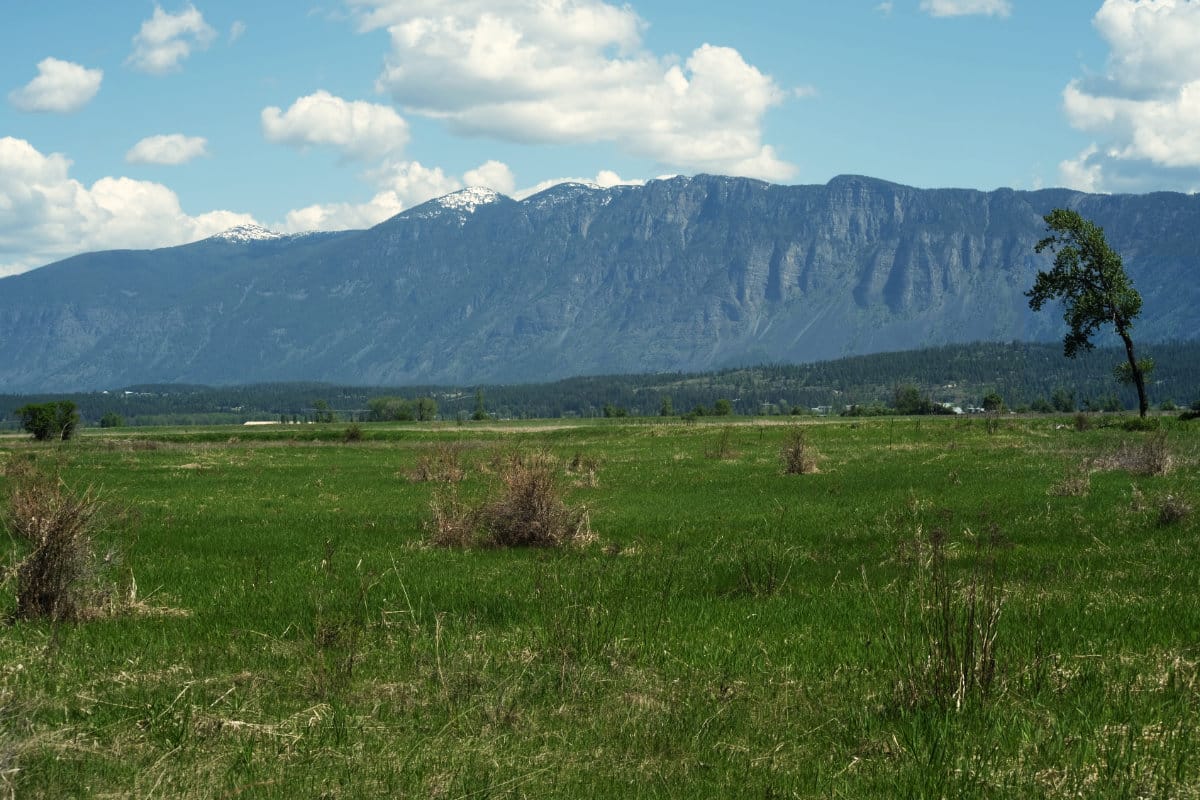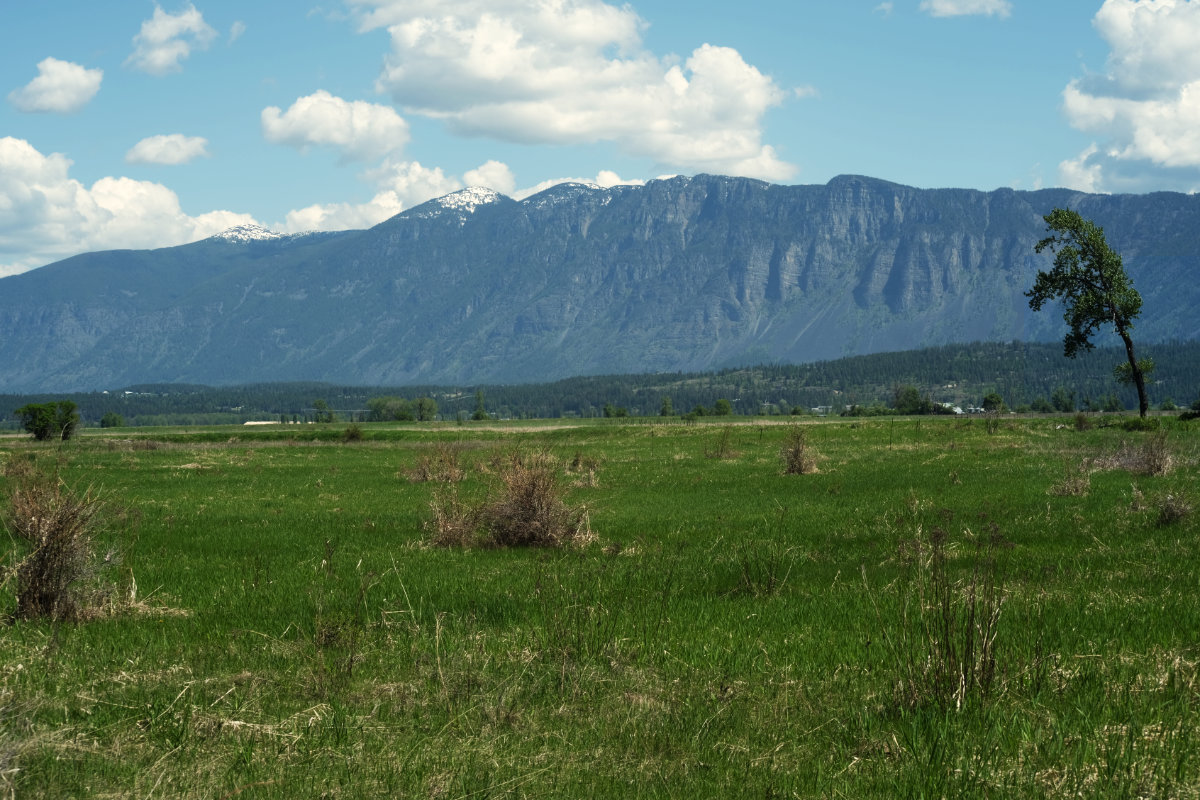Smith Creek Thoughts
An Essay

Yesterday dawned bright and clear and though these are poor conditions for interesting photos I stirred myself and went out to explore some more local territory. I settled on a wildlife refuge north of Bonner’s Ferry right on the Canadian border.
I packed a sandwich, a beer, and planned some hiking before lunch. This end of the Selkirks is as steep as they are anywhere. The day was lovely and the sun warm and bright. I ended up at Smith Creek Wildlife refuge at a picnic area near the banks of Smith Creek and had the place to myself.
The refuge sits in the Kootenai river valley where it flow north over the Canadian border. The Kootenai here is a big strong-currented river that you would never have heard of despite its size. It is the river that required the services of Bonner’s Ferry. It derives its name from the local Indian tribe.
The Kootenai meanders this broad valley called the Purcell Trench. The trench is the result of geologic faulting and later glacial carving. I imagine it was once a rich marshland populated by uncountable migratory waterfowl. Now it is broad flat farmland ‘recovered’ as they say, from its marshy existence. In this way it is much like the Fens of East Anglia in England. Here they grow cereal grains and rather surprisingly Anheuser-Busch has a vast hop farm complex. The refuge in its small area has attempted to undo this human work to ‘recover’ habitat for birds, and otters, bear, deer, and elk.

All along the valley streams, creeks, and rivers rush down the rocky mountain valleys tumbling in a loud rush of white water and white noise over polished boulders of mountain core and glacial moraine. Such energy and power. All is tamed in a few hundred yards in this flat valley floor. Tamed to a smooth surface, the rivers reveal their turmoil with occasional riffles and eddies as they flow past steep banks and green pasture or meadows.
All about this vast valley are the mountains of the Selkirks and Purcells and other ranges far into Canada; still clinging on the upper slopes are the heavy snows of last winter.
One becomes aware of the ambitious engineering used to capture the snow melt and make the land ‘productive’. Rivers are bound by dikes to ensure they don’t tarry and instead are hurried to the shores of the Kootenai. The valley is ringed with dikes and ditches to catch the smaller rivulets, brooks, and freshets and dispatch them to their larger cohort.
It takes some mental gymnastics for someone who grew up in the arid American Southwest to imagine dykes, canals, and other earthworks being used to deplete the land of water. In Arizona, the prehistoric Hohokam people built canals and diversions to flood the land. Here in water-rich Northern Idaho all this work is to rid the land of water.
Elsewhere on this day I find other evidence of ‘progress’. I venture up Smith Creek, as far up the road as the rapidly melting snow dares me. (The short video here was taken along this road as the snow-melt created numerous seeps and falls along the road.)
A small drama provides a diversion from my ponderings… I carry no shovel and am all alone. I know the limitations of a four-wheel drive. Dale Little, my dad’s business partner from our days in Flagstaff once remarked that four wheel drive allows one to get stuck in more remote places. I spent a good portion of my youth proving him correct.
Sure enough, just short of where I was forced to turnaround I found evidence of Dale’s epithet. A GMC Yukon lay abandoned on a stretch of the Forest Service road, parked against the edge of the ditch. As I passed it again on my way down the road I examined its strange appearance. At first glance, I assumed someone was out gathering mushrooms or hiking. But there was a puzzling collection of plastic bowls and mugs and a bundle of 2x4 lumber. A different scene materialized with socks and gloves on the dashboard arranged as if to dry, there were snow chains on the tires; although at least one had not managed to have the task completed.
Now a fuller story emerged. Perhaps a family out for a drive in the snow. They got stuck and tried to dig themselves out with what they had, bowls and plastic mugs. Perhaps next they tried to put the chains on. But these would only dig in deeper and the truck would be left high centered on a ridge of heavy compacted snow. With a shovel and time one could eventually dig out of this situation. But without the ability to dig underneath the truck the cause was lost. I know this from hard earned experience.
Now with no snow on the road it creates a puzzle with the last unanswered question; why is it still here? The road has been passable for weeks now. Were the owners unaware, ashamed, or perhaps, forced to move somewhere else, or live at great distance? Not quite the Donner party but grist for contemplation.
And as to the signs of progress there is a side road near here, a small dam, and a steel building with signs proclaiming the purpose. A diversion of the stream into a 6-foot diameter pipe. Fitted with trash and fish screens and a fish ladder the sign proclaims in self-defense to be a dam of the most ecologically advanced design (at least for 1990 when it was built). The fish protected from going the wrong way downstream and enabled to progress (that word again) upstream. Power for forty thousand homes (this is the standard unit of measure for hydroelectric projects, power for the people) a pit toilet, two picnic benches, and a tarmac path to the stream’s edge all proclaimed as a series of benefits.
My jaundiced eye, developed in the shadow of Glen Canyon dam, see the latter as a sop to the idea of ‘land of many uses’. The diversion pipe I presume traveled under the road I drove up on. The sign tells me it emerges 5.5 miles downstream just above Smith Creek Falls where it turns a generator for the benefit of those 40,000 hypothetical homes, the dam constructed by Eugene Electric and Water Board. (Yes Eugene Oregon)
I certainly hope all of the earnest assurances are true. The fish are safe, the river protected. But I can’t help wondering if Smith Creek, which runs into the Kootenai, which in turn becomes the Columbia and then the Pacific ocean, what fish they are protecting. There are by my count about 13 other dams between the Pacific and here. I did look earlier in the day for salmon in the Smith. A habit I developed living in Oregon. I didn't see any but don’t know when the runs are timed here in any case.
Further research indicates the fish being protected is the White Sturgeon. The story of this fish is not a happy one here. The White Sturgeon of the Kootenai is a land-locked population that consists entirely of an ‘aging cohort of large older fish’ according to the US Fish and Wildlife Service. The short article reads like a draft of an obituary. Numbering 7000 in the late 70’s they estimate in seven years from now to be fewer that 50. Fourteen years of intensive monitoring has turned up one hatching embryo. They live perhaps 100 years.
Before leaving on this sad note this whole encounter causes me to contemplate the shifting nature of relationships with the land and power. The Smith Creek hydroelectric project developed by some entity and sold to the Eugene Electric and Water Board a publicly owned utility in Eugene Oregon. The project delivers its power to the Bonneville Power Administration (BPA) power distribution network at Bonner’s Ferry.
Politically the BPA was as progressive a government entity as one could ask for. None other than Woody Guthrie literally sung its praises as it brought power, prosperity, and progress to an impoverished area of the Pacific Northwest. ‘Your power is turning our darkness to dawn, roll on Columbia roll on.’
Over time as the impact of these dams became evident on salmon and sturgeon populations the political attitudes shifted. The progressive view now saw the benefit of removal of Pacific Northwest dams and indeed a few have been demolished.
Further on, as the impact of climate change became more acute, the benefit of low-carbon hydropower has left a quandary for the environmentally conscious person. The irony does not end there with the progressive end of politics. (I can attest that electricity is cheap in the region, I pay about $.10 per Kilo-watt-hour. In Britain it is closer to $.40. It is so cheap here I cannot imagine how to justify a solar project. Indeed one sees little evidence of solar energy here.)
For generations, the Inland Northwesterners have come to take the prosperity brought by the BPA for granted. A mythology developed that prosperity was wrought from the land purely based on individual effort and initiative. Suddenly any form of collective effort was seen as socialism and to be avoided.
Today as one drives up to Bonner’s Ferry from Sandpoint, one encounters a large well-made sign proclaiming, as if entering a sovereign territory, that you are in Trump Country ‘Love God, Guns, Family, Freedom, and your Neighbor’. In Bonner’s Ferry the power is produced and distributed by the municipal power company, owned by the city, and purchases additional power from the BPA. But last year the battle was over the local library, perhaps nobody had noticed how the government has taken over their electricity supply.


